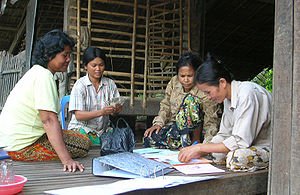Our understanding of microfinance institutions is limited. It means different things to different people. Broadly, MFIs are neither exactly like government nor like businesses. They fall somewhere in between. They try to meet the challenges which typically fall in the domain of state with business-like approach. Their horizon tend to be shorter than the state and profit making is not central to their philosophy. These institutions, as opposed to the standardization method of the market and of the state, move towards developing localized solution to create insularity.
 |
| Community-based savings bank in Cambodia (Photo credit: Wikipedia) |
Poverty, Inequality and injustice act as an impediment to a nation’s economic growth. They lead to a lopsided version of the society where the distribution of power and resources gets concentrated in the hands of few people. Initially, the poor had no access to loans from the financial institutions as they were not considered ‘bankable’. The cost of servicing this group used to be considered too high to make lending to this group profitable. In this landscape, microfinance institutions emerged as ‘niche’ players to cater to the needs of this ignored stratum. Regardless of their size, location and type of solution provided, all microfinance interventions had the common goal of social uplifting of the deprived.
Today, thousands of microfinance institutions around the world are becoming successful in their attempt to do well by ‘doing good’. This development has caught the imagination of banks and other financial institutions across the globe. Microfinance model offers an institutional framework to provide easy access to credit for the poor. The scale problem, however, needs to be resolved so that it can reach more people who demand access to credit at market rates. To successfully accomplish their mission, they must achieve high repayment rates, cut down their SG&A expenses, and expand their reach. Cost reduction can be achieved through simplified and standardized procedures, as the cases in point – Grameen bank and Association for Social Advancement (ASA) – proved with their successful execution of standardized and non-negotiable loan applications.
As I mentioned earlier, microfinance lending is mainly a social initiative. Nonetheless, in recent years a certain sense of commercial viability has been pegged with it. Some have argued that only a commercial approach, with checks and balances in place, can lead to institutional sustainability. The question now is can we provide commercial services ethically? The major problem with this proposition is that the ethical boundaries cannot be defined by financial ratios. Professionalized organizations use concepts from for-profit models. But adoption of these models has its own ramifications; MFIs are much more complex entities than their purely for-profit counterparts. The microfinance environment involves managing diverse stakeholders. As a result of multiple constituents, stakeholders, relationships, and revenue streams, these organizations tend to have multiple bottom lines as opposed to just one in case of for-profit organizations. So contrary to the popular perception, for-profit model is actually too primitive to be applied to microfinance institutions as it fails to meet their needs.
Microfinance is a business which essentially deals with the poorest section of the society and hence right signaling becomes critical for the success of MFIs. Organizations which transformed themselves to for-profit from not-for-profit have attracted the maximum attention and criticism than those which started as for-profit from the beginning. Clearly the role of signaling is very strong, for example, people started questioning the intention of Compartamos when it became Banco Compartamos after issuing the IPO. Something similar happened in India in case of SKS microfinance.
The microfinance industry has been criticized for the cases of extremely high interest rates, profit-making behavior, and over-indebtedness of the borrowers. Another not-so-apparent and much less-debated phenomenon in microfinance is mission drift where an MFI increases its average loan size by reaching out to wealthier clients neither for progressive lending nor for cross-subsidization reasons. Moreover, increasing competition, easy access to capital and lack of transparency may lure MFIs to distract from their mission.
To survive in today’s rapidly changing environment these organizations must tackle the problem of mission drift, manage the perceptions of the society and prudently apply the elements of for-profit business models to further their mission. MFIs can successfully do this by recruiting board members with focus on strategic goals as well as on community development. In turn, board of directors should choose CEO, who is driven by the mission and possesses necessary skills required to manage the unique nature of MFIs. As discussed in this article, microfinance institutions are complex entities and therefore they need multiple management models to address this situation.
Despite monumental success of microfinance in countries like Bangladesh, we have not been able to curb poverty. To eliminate poverty, we need to bring in innovation in products and services. Participation from private sector alone is not sufficient; the state should also assist in development of microfinance markets by providing intellectual as well as regulatory infrastructure.
[The article has been written by Rahul KM. He is an electrical engineer from NIT Jaipur and has completed his PGDM from IIM Bangalore. His interests include Corporate finance, statistics and macroeconomics. ]

































